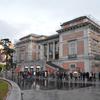More about The Birth of the Milky Way
- All
- Info
- Shop

Editor
The infancy of Hercules as depicted in The Origin of the Milky Way by Rubens is not what Disney would have you believe.
Forget about cute cradles, prancing Pegasus babies, or cooing parents. Like Tintoretto in his earlier version of The Origin of the Milky Way, Rubens gives us the actual myth in all its galactic lactation glory. It turns out little Hercules was actually the illegitimate child of Jupiter (Zeus) and a mortal, Alcmene, whom he had tricked into sleeping with him by pretending to be her husband, Amphitryon. Because he was born of a human, Hercules lacked immortality, so Jupiter did what any sensible father would do: he sneaked that baby up to Mt. Olympus and placed him at his sleeping wife Juno’s breast. Juno just happened to be lactating, and the baby latched on greedily, only to chomp down too hard in his enthusiasm and rouse both the goddess and her ire.
As she yanked her breast away from Hercules, her immortal-life giving milk streamed into the sky, where it created, you guessed it, the Milky Way. (Is this why breastfeeding women get told to cover up in public? Fear they might just shoot out a solar system?) Rubens’ own considerable body of lactation imagery suggests that he himself would never have urged a woman to cover up. Indeed, in Rubens’ day, breast milk was considered an important remedy for almost any ailment, even those afflicting adults, so lactating was really a majestic business of creation and renewal, even if it was also tinged with the erotic. Maybe that’s why he felt comfortable using his wife and favorite muse, Hélène Fourment, as the model for Juno.
This painting comes from a series commissioned in 1636 by Philip IV of Spain when he was renovating his hunting lodge, the Torre de la Parada. Although he also commissioned some works from his own court painter Velázquez, the largest commission went to Rubens, who was asked to paint sixty mythological scenes. Rubens knew mythology like nobody else, so this was his big chance to design a whole program, an entire world, of classical myth. Rubens carried out the bulk of his work in Antwerp, where he enlisted a team of fellow artists to carry out the paintings after his own sketches. Only 15 months after receiving the commission, Rubens and his team had already completed 56 paintings. Many of them, like Saturn Devouring his Son, are in the Prado today.
Cardinal-Infante Ferdinand, the King’s brother and governor of the Spanish Netherlands, would check in from time to time on Rubens’ progress, and he was quite disturbed by all the nude figures. Ever the diplomat, Rubens pretended to care, but said alas, it was too late to change them, and shipped them off to the King, who (believe it or not) didn’t seem to mind. Seldom promiscuous, the nudes in these late mythology paintings reflect Rubens’ evolving interests as an artist. Unlike in earlier works, the emphasis is less on their flesh than on the narrative and emotional content of the stories they are enacting. Yes, they are noticeably large and naked, but their nudity and sheer heftiness lend them a monumental, mythologized appearance and serve to convey their exuberance and good health.
The Torre de la Parada works, based primarily on Ovid’s "Metamorphoses" (though this story may be drawn from the “Geoponica,” a 10th century Byzantine botanical textbook) demonstrate Rubens’ prioritization of story and psychological nuance in his project to explore human emotion through classical myth. With their unified compositions and meaningful gestures, they represent the pinnacle of his artistic career, the last hurrah before he succumbed to gout-related heart failure in 1640. The fact that Rubens could get away with painting nude female figures, one of his great specialties, in his quest to convey the human condition was just the icing on the cake of this once-in-a-lifetime project.
Sources
- Belkin, Kristin Lohse. Rubens. London: Phaidon, 1998.
- Sperling, Jutta Gisela. Medieval and Renaissance Lactations: images, rhetorics, practices. Burlington, VT: Ashgate, 2013.
- Wedgewood, C.V. The World of Rubens: 1577-1640. New York: Time Incorporated, 1967.
- “The Birth of the Milky Way.” Museo del Prado. Accessed March 5, 2018. https://www.museodelprado.es/en/the-collection/art-work/the-birth-of-th…
- “The Origin of the Milky Way.” The National Gallery. Accessed March 5, 2018. https://www.nationalgallery.org.uk/paintings/jacopo-tintoretto-the-orig…
Featured Content
Here is what Wikipedia says about The Birth of the Milky Way
The Birth of the Milky Way, also sometimes known as The Origin of the Milky Way, is an oil-on-canvas painting by the Flemish artist Peter Paul Rubens, produced between 1636 and 1638 and featuring the Greco-Roman myth of the origin of the Milky Way. The painting depicts Hera (Juno), spilling her breast milk, the infant Heracles (Hercules) and Zeus (Jupiter) in the background, identifiable by his eagle and lightning bolts. Hera's face is modelled on Rubens' wife, Hélène Fourment. The carriage is pulled by peacocks, a bird which the ancient Greeks and Romans considered sacred to both themselves and to Hera/Juno, as a result of their ability to signal changes in weather through cries and hence their perceived connection to the gods.
With a width of 244 cm (96 in) and height of 181 cm (71 in), the image was a part of the commission from Philip IV of Spain for Rubens, along with other painters such as Diego Velázquez, to decorate Torre de la Parada, the monarch's recreational house and hunting lodge located on Monte de El Pardo. The commission consisted of 112 paintings based on Ovid's Metamorphoses, including this painting. The latter is now held in room 79 at the Museo del Prado, in Madrid, with inventory number P01668.
Check out the full Wikipedia article about The Birth of the Milky Way

















